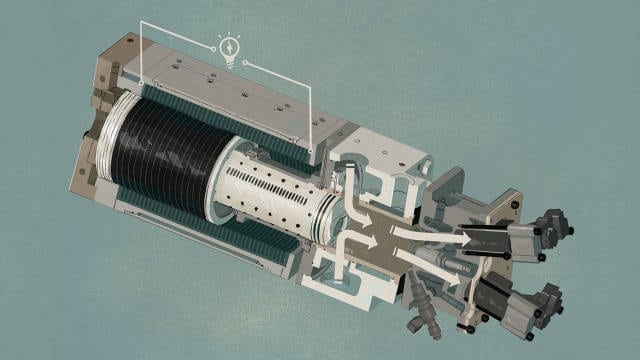A new engine idea, which combines an electric generator with a combustion engine’s piston, is being credited to Toyota’s research and development arm. Though we couldn’t find proof of Toyota’s plans to actually build these, we are intrigued by the idea of replacing the standard combustion-to-spin effect of a crankshaft-laden engine with a simpler combustion-to-electricity method.
Called the Free Piston Engine Linear Generator (FPEG), the complete unit is thin, compact, and produces about 10kW of power. A paper introduced at the SAE 2014 World Congress in Detroit by the researchers developing the technology claims that a standard passenger vehicle similar to the Prius could be fully powered to highway speeds (75 mph) by two of these cylinders acting in tandem. Logically, more or fewer cylinders could be used to power different sized vehicles, such as one cylinder on a motorcycle and four on a large truck.
The basic premise is to build a two-stroke combustion chamber with fuel-air injection ahead of a linear generator surrounding a gas spring chamber. Fuel and air are injected and ignited as with any combustion engine (we can assume diesel would be possible here, though the video shows a gasoline setup). That ignition pushes the piston down the cylinder, again just as in most ICE engines of today. That piston, however, does not connect to a crank shaft to convert the lateral motion to spinning motion, but instead shoves a magnet down a shaft lined in a coil. This generates electricity in much the same way a “shake to charge” flashlight (“shaker light”) does. The return stroke comes from air which has been compressed inside the piston’s gas-filled shaft (much like a shock absorber, but without a physical spring). This “air-spring” acts to both cushion the stroke conversion (from down to up) and to control timing.
The name of the engine might be misleading to some. It’s not “free” of pistons, but the piston is “free” of other objects (specifically the crankshaft). Putting two of these pistons in a boxer-style configuration would create a naturally-balanced engine capable of producing about 15 horsepower and 20kW of electricity. The engineers claim a 42 percent thermal-efficiency rating for this engine under continuous use, which is far better than nearly all other combustion engines currently in use – including those commonly used as generators in vehicles like the Volt, Prius Plug-in, etc.
20kW is enough to keep a small vehicle like the Prius Liftback at highway speeds without battery use. The engine itself would be smaller and more compact than current engine-transmission setups in most hybrids and far smaller than the relatively large engine in the Chevrolet Volt. Total engine size would be about two feet long and eight inches around plus accessories – roughly half the size of a four-cylinder Atkinson-cycle engine such as those used in the Prius.
Of course, the FPEG would be useful only in electric cars as a range extender, so vehicles like the standard Prius would not benefit from this engine design. Plug-in vehicles, however, including current battery-electrics, could see lots of benefits from an FPEG.







